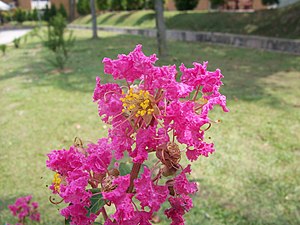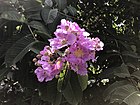Note: This is a project under development. The articles on this wiki are just being initiated and broadly incomplete. You can Help creating new pages.
Difference between revisions of "Lagerstroemia speciosa"
(Created page with "{{stub}} ==Uses== {{Uses|}}, {{Uses|}}, {{Uses|}}, {{Uses|}}, {{Uses|}}, {{Uses|}}, {{Uses|}}, {{Uses|}}, {{Uses|}}, {{Uses|}}, {{Uses|}}.<ref name="Uses"/> ==Parts Used== {{...") |
|||
| (11 intermediate revisions by the same user not shown) | |||
| Line 1: | Line 1: | ||
| − | + | [[File:Bongor (2292243443).jpg|thumb|right]] | |
| + | '''Lagerstroemia speciosa''' is a fast-growing, medium-sized, deciduous, sub-canopy tree. It is produces suckers, usually grows 15 metres tall. The bole is around 60cm in diameter. | ||
==Uses== | ==Uses== | ||
| − | {{Uses|}}, {{Uses|}}, {{Uses|}}, {{Uses|}}, {{Uses|}}, {{Uses|}}, {{Uses| | + | {{Uses|Diabetes}}, {{Uses|Urinary problems}}, {{Uses|Cracked feet}}, {{Uses|Diarrhea}}, {{Uses|Abdominal pains}}, {{Uses|Constipation}}, {{Uses|Fever}}.<ref name="Uses"/> |
==Parts Used== | ==Parts Used== | ||
| − | {{Parts Used|}}, {{Parts Used| | + | {{Parts Used|Bark}}, {{Parts Used|Fruits}}, {{Parts Used|Leaves}}<ref name="Karnataka Medicinal Plants"/> |
==Chemical Composition== | ==Chemical Composition== | ||
| − | <ref name="chemical composition"/> | + | It contains four triterpenes (1–4), eight ellagic acids (5–12), one coumarin (13) and one neolignan (14). Their structures were elucidated on the basis of various spectroscopic methods (UV, IV and NMR, including 2D experiments).<ref name="chemical composition"/> |
==Common names== | ==Common names== | ||
| − | {{Common names|sa=|en=|gu=|hi=|kn=|ks=|ml=|mr=|pa=|ta=|te=}} | + | {{Common names|sa=Kramuka|en=Queen Crape Myrtle, Pride of India|gu=Moto bhondaro|hi=Jarul|kn=ಹೊಳೆ ದಾಸವಾಳ Hole dasavala|ks=|ml=Adambu|mr=Taman|pa=|ta=Kadali|te=Chennangi}}<ref name="Common names"/> |
==Properties== | ==Properties== | ||
| Line 16: | Line 17: | ||
===Dravya=== | ===Dravya=== | ||
===Rasa=== | ===Rasa=== | ||
| − | |||
===Guna=== | ===Guna=== | ||
| Line 29: | Line 29: | ||
==Habit== | ==Habit== | ||
| − | {{Habit|}} | + | {{Habit|Deciduous tree}} |
==Identification== | ==Identification== | ||
| Line 36: | Line 36: | ||
===Flower=== | ===Flower=== | ||
| − | {{Flower||||}} | + | {{Flower|||||Flowering season is April - June}} |
===Fruit=== | ===Fruit=== | ||
| − | {{Fruit||||||}} | + | {{Fruit||||||Fruiting season is April - June}} |
===Other features=== | ===Other features=== | ||
| Line 48: | Line 48: | ||
==Mode of Propagation== | ==Mode of Propagation== | ||
| − | {{Propagation|}} | + | {{Propagation|Seeds}}, {{Propagation|Cuttings}}, {{Propagation|Division of root suckers}}. |
==How to plant/cultivate== | ==How to plant/cultivate== | ||
| − | <ref name="How to plant/cultivate"/> | + | A plant of the moist, lowland tropics and subtropics, where it is found at elevations up to 400 metres. It grows best in areas where annual daytime temperatures are within the range 18 - 35°c, but can tolerate 6 - 43°c.<ref name="How to plant/cultivate"/> |
==Commonly seen growing in areas== | ==Commonly seen growing in areas== | ||
| − | {{Commonly seen|}}, {{Commonly seen|}}, {{Commonly seen|}}, {{Commonly seen| | + | {{Commonly seen|In open vegetation types}}, {{Commonly seen|Often coastal areas}}, {{Commonly seen|In swamps}}, {{Commonly seen|Along rivers}}. |
==Photo Gallery== | ==Photo Gallery== | ||
<gallery class="left" caption="" widths="140px" heights="140px"> | <gallery class="left" caption="" widths="140px" heights="140px"> | ||
| − | + | Flower photo at night in Shekou.jpg | |
| + | Flowers & leaves I IMG 1864.jpg | ||
| + | Flowers of Lagerstroemia speciosa 20170914.jpg | ||
| + | Fruit, leaves & Drongo I IMG 5962.jpg | ||
| + | HK Sheung Wan 上環 磅巷 Pound Lane stairs tree Feb-2016 DSC 001 (1).JPG | ||
</gallery> | </gallery> | ||
| Line 64: | Line 68: | ||
<references> | <references> | ||
| − | <ref name="chemical composition"> | + | <ref name="chemical composition">Biochemical Systematics and Ecology Volume 51, Pages 109-112</ref> |
| − | <ref name="Leaf">[" | + | <ref name="Leaf">[Morphology]</ref> |
| + | |||
| + | <ref name="Common names">[https://sites.google.com/site/indiannamesofplants/via-species/l/lagerstroemia-speciosa Common names]</ref> | ||
| + | |||
| + | <ref name="How to plant/cultivate">[http://tropical.theferns.info/viewtropical.php?id=Lagerstroemia+speciosa Cultivation]</ref> | ||
| − | |||
<ref name="Uses">Indian Medicinal Plants by C.P.Khare</ref> | <ref name="Uses">Indian Medicinal Plants by C.P.Khare</ref> | ||
| + | |||
| + | <ref name="Karnataka Medicinal Plants">"Karnataka Medicinal Plants Volume - 2" by Dr.M. R. Gurudeva, Page No.777, Published by Divyachandra Prakashana, #45, Paapannana Tota, 1st Main road, Basaveshwara Nagara, Bengaluru. </ref> | ||
</references> | </references> | ||
==External Links== | ==External Links== | ||
| − | * [ ] | + | * [http://www.flowersofindia.net/catalog/slides/Queen%20Crape%20Myrtle.html Lagerstroemia speciosa on flowersofindia.net] |
| − | * [ | + | * [https://ijpsr.com/bft-article/a-review-on-lagerstroemia-speciosa/?view=fulltext Lagerstroemia speciosa on ijpsr.com] |
| − | |||
[[Category:Herbs]] | [[Category:Herbs]] | ||
| + | [[Category:Pages without herbs images]] | ||
Latest revision as of 11:40, 13 August 2023
Lagerstroemia speciosa is a fast-growing, medium-sized, deciduous, sub-canopy tree. It is produces suckers, usually grows 15 metres tall. The bole is around 60cm in diameter.
Contents
- 1 Uses
- 2 Parts Used
- 3 Chemical Composition
- 4 Common names
- 5 Properties
- 6 Habit
- 7 Identification
- 8 List of Ayurvedic medicine in which the herb is used
- 9 Where to get the saplings
- 10 Mode of Propagation
- 11 How to plant/cultivate
- 12 Commonly seen growing in areas
- 13 Photo Gallery
- 14 References
- 15 External Links
Uses
Diabetes, Urinary problems, Cracked feet, Diarrhea, Abdominal pains, Constipation, Fever.[1]
Parts Used
Chemical Composition
It contains four triterpenes (1–4), eight ellagic acids (5–12), one coumarin (13) and one neolignan (14). Their structures were elucidated on the basis of various spectroscopic methods (UV, IV and NMR, including 2D experiments).[3]
Common names
| Language | Common name |
|---|---|
| Kannada | ಹೊಳೆ ದಾಸವಾಳ Hole dasavala |
| Hindi | Jarul |
| Malayalam | Adambu |
| Tamil | Kadali |
| Telugu | Chennangi |
| Marathi | Taman |
| Gujarathi | Moto bhondaro |
| Punjabi | |
| Kashmiri | |
| Sanskrit | Kramuka |
| English | Queen Crape Myrtle, Pride of India |
Properties
Reference: Dravya - Substance, Rasa - Taste, Guna - Qualities, Veerya - Potency, Vipaka - Post-digesion effect, Karma - Pharmacological activity, Prabhava - Therepeutics.
Dravya
Rasa
Guna
Veerya
Vipaka
Karma
Prabhava
Habit
Identification
Leaf
| Kind | Shape | Feature |
|---|---|---|
Flower
| Type | Size | Color and composition | Stamen | More information |
|---|---|---|---|---|
| Flowering season is April - June |
Fruit
| Type | Size | Mass | Appearance | Seeds | More information |
|---|---|---|---|---|---|
| Fruiting season is April - June |
Other features
List of Ayurvedic medicine in which the herb is used
Where to get the saplings
Mode of Propagation
Seeds, Cuttings, Division of root suckers.
How to plant/cultivate
A plant of the moist, lowland tropics and subtropics, where it is found at elevations up to 400 metres. It grows best in areas where annual daytime temperatures are within the range 18 - 35°c, but can tolerate 6 - 43°c.[6]
Commonly seen growing in areas
In open vegetation types, Often coastal areas, In swamps, Along rivers.
Photo Gallery
References
- ↑ Indian Medicinal Plants by C.P.Khare
- ↑ "Karnataka Medicinal Plants Volume - 2" by Dr.M. R. Gurudeva, Page No.777, Published by Divyachandra Prakashana, #45, Paapannana Tota, 1st Main road, Basaveshwara Nagara, Bengaluru.
- ↑ Biochemical Systematics and Ecology Volume 51, Pages 109-112
- ↑ Common names
- ↑ [Morphology]
- ↑ Cultivation
External Links
- Ayurvedic Herbs known to be helpful to treat Diabetes
- Ayurvedic Herbs known to be helpful to treat Urinary problems
- Ayurvedic Herbs known to be helpful to treat Cracked feet
- Ayurvedic Herbs known to be helpful to treat Diarrhea
- Ayurvedic Herbs known to be helpful to treat Abdominal pains
- Ayurvedic Herbs known to be helpful to treat Constipation
- Ayurvedic Herbs known to be helpful to treat Fever
- Herbs with Bark used in medicine
- Herbs with Fruits used in medicine
- Herbs with Leaves used in medicine
- Herbs with common name in Kannada
- Herbs with common name in Hindi
- Herbs with common name in Malayalam
- Herbs with common name in Tamil
- Herbs with common name in Telugu
- Herbs with common name in Marathi
- Herbs with common name in Gujarathi
- Herbs with common name in Sanskrit
- Herbs with common name in English
- Habit - Deciduous tree
- Index of Plants which can be propagated by Seeds
- Index of Plants which can be propagated by Cuttings
- Index of Plants which can be propagated by Division of root suckers
- Herbs that are commonly seen in the region of In open vegetation types
- Herbs that are commonly seen in the region of Often coastal areas
- Herbs that are commonly seen in the region of In swamps
- Herbs that are commonly seen in the region of Along rivers
- Herbs
- Pages without herbs images





